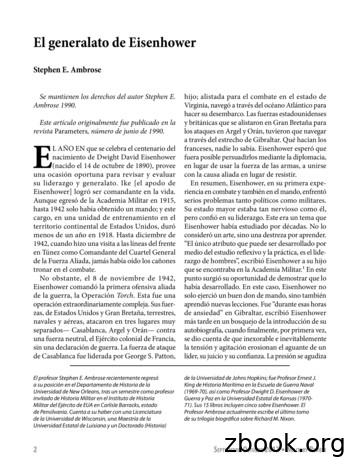EISENHOWER ON D-DAY
LESSON PLANEISENHOWER ON D-DAYComparing Primary and Secondary Sources(Library of Congress, LC-USZ62-25600.)INTRODUCTIONOBJECTIVEOn June 6, 1944, more than 175,000Allied troops stormed the beaches ofNormandy, France, in what became thelargest amphibious military invasion inhistory. Countless military and politicalofficials spent years planning for thisoperation, and yet the decision to finallylaunch the attack rested with SupremeAllied Commander Dwight D. Eisenhower.On the morning of D-Day, he issued an“order of the day” to all Allied personnelinvolved in the operation. He madenumerous edits to the text before approvingit in its final form, a testament to theimportance he attached to this documentand the invasion it described. In thisactivity, students will analyze Eisenhower’sOrder of the Day message along with asecondary source about the Normandyinvasion to compare and contrast howhistorians and historical actors use factsand language to explain historical events.Students will analyze both a primary sourceand a secondary source about the 1944Normandy invasion to understand howhistorical actors and historians alike usefacts and language to develop historicalnarratives.GRADE LEVEL7–12TIME REQUIREMENT1–2 class periodsONLINE RESOURCESww2classroom.orgD-Day Invasion VideoRoland Chaisson Oral HistoryBreakout from Normandy MapEisenhower's Order of the Day52LESSON PLANEISENHOWER ON D-DAYThe War in Europe
TEACHERSTANDARDSCOMMON CORE STANDARDSCCSS.ELA-LITERACY.RH.6-8.2Determine the central ideas or information of a primary or secondary source; provide an accuratesummary of the source distinct from prior knowledge or opinions.CCSS.ELA-LITERACY.RH.6-8.6Identify aspects of a text that reveal an author's point of view or purpose (for example, loadedlanguage, inclusion or avoidance of particular facts).CCSS.ELA-LITERACY.RH.6-8.8Distinguish among fact, opinion, and reasoned judgment in a text.CCSS.ELA-LITERACY.RH.6-8.9Analyze the relationship between a primary and secondary source on the same topic.CCSS.ELA-LITERACY.RH.9-10.5Analyze how a text uses structure to emphasize key points or advance an explanation or analysis.CCSS.ELA-LITERACY.RH.11-12.2Determine the central ideas or information of a primary or secondary source; provide an accuratesummary that makes clear the relationships among the key details and ideas.CCSS.ELA-LITERACY.RH.11-12.5Analyze in detail how a complex primary source is structured, including how key sentences,paragraphs, and larger portions of the text contribute to the whole.NATIONAL STANDARDS FOR HISTORYHISTORICAL CONTENT ERA 8, STANDARD 3AThe student understands World War II and how the Allies prevailed.HISTORICAL THINKING STANDARD 2The student is able to identify the central question(s) the historical narrative addresses and thepurpose, perspective, or point of view from which it has been constructed.The student is able to differentiate between historical facts and historical interpretations butacknowledge that the two are related; that the facts the historian reports are selected and reflecttherefore the historian’s judgment of what is most significant about the past.The student is able to read historical narratives imaginatively, taking into account what the narrativereveals of the humanity of the individuals and groups involved—their probable values, outlook,motives, hopes, fears, strengths, and weaknesses.HISTORICAL THINKING STANDARD 5The student is able to identify issues and problems in the past and analyze the interests, values,perspectives, and points of view of those involved in the situation.LESSON PLANEISENHOWER ON D-DAYThe War in Europe53
TEACHERPROCEDURES1. Have students read the Normandy Invasion Overview Essay either silently or aloud as a wholeclass, underlining the most important statements of fact and circling the most importantstatements of opinion or interpretation. Explain that the essay presents one explanation of theNormandy invasion, reminding them that historia
3. Use the discussion guide to check students’ understanding of the essay and the difference between facts and opinion/interpretation. 4. Introduce Eisenhower’s Order of the Day as a primary source that can help us understand how the Normandy invasion was viewed by the
Eisenhower’s grand strategy Eisenhower‟s foreign policy agenda was shaped by a distinct grand strategy for dealing with the Soviet Union and the threat of communism. Like Harry Truman, his predecessor, Eisenhower th
890 CHAPTER 38 The Eisenhower Era, 1952–1960. his own throat by parading his essential meanness and irresponsibility. A few months later, the Senate formally condemned him for “conduct unbecoming, CHAPTER 38 The Eisenhower Era, 1952–1960. 38 The Eisenhower Era, 1952–1960.
The Eisenhower Era 1952 – 1960 . Affluence and Its Anxieties Prosperity in the 1950s –Changed US society . Affluence and Its Anxieties . –Saved his candidacy as vice president . The Advent of Eisenhower Results of the election of 1952 –Eisenhower
The Diary/Dictation folders contain letters as well as journal entries. These letters, which Eisenhower personally dictated, are to friends, family members, public figures, and members of his . Two other sets of files give a good indication of the course of President Eisenhower's day and the daily flow of paper and people through the Oval .
King de Historia Marítima en la Escuela de Guerra Naval (1969-70), así como Profesor Dwight D. Eisenhower de Guerra y Paz en la Universidad Estatal de Kansas (1970-71). Sus 15 libros incluyen cinco sobre Eisenhower. El Profesor Ambrose actualmente escribe el últi
The Eisenhower Matrix WHAT IS IT? Developed by the 34th US President Dwight D. Eisenhower, the Eisenhower Matrix allows you to create a system of prioritizing the most important tasks so that they don’t get lost to the sudden, unexpected tasks that always seem to arise out of nowhere. T
White House chief of staf Sherman Adams took on such an outsized management role that he earned the title assistant president. In reality, Eisenhower formulated foreign policy in the Eisenhower administration; Secretary Dulles
Campaign for U. S. Senate, 1950; Eisenhower-Nixon . Campaign A New Kind of Vice President Preparation of a President What President Eisenhower thinks of Nixon The Steel Strike Pat Nixon . III. The Eisenhower -Nixon Record . More Jobs Better Jobs and Better-Paying Jobs Prices Economic Growt























